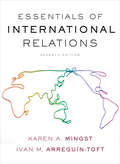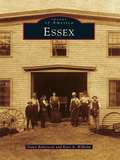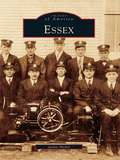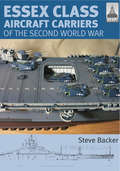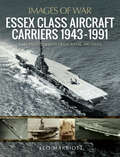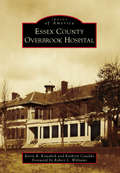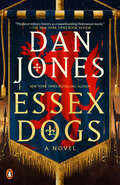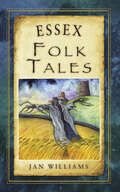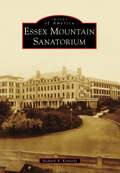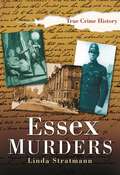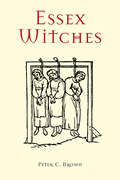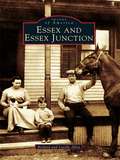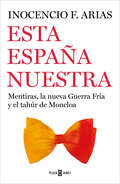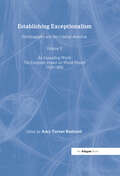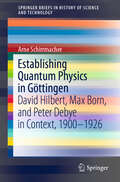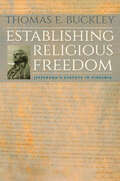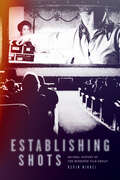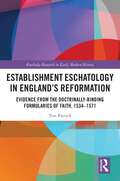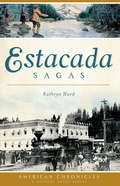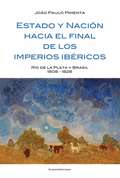- Table View
- List View
Essentials of International Relations
by Ivan M. Arreguin-Toft Karen MingstEssentials of International Relations has long provided the clearest explanations of core concepts and theories; in its Seventh Edition, robust new “Behind the Headlines” features and engaging new chapter openers help students more easily draw connections between international relations concepts and today’s political climate.
Essex (Images of America)
by Kurt A. Wilhelm Dawn RobertsonEssex is nestled on the Atlantic coast within beautifully preserved hills, forest, fields, and wetlands--but the serene landscape belies the town's rich history. According to tradition, the first Essex boat was built in an attic around 1660. Eventually, this shipbuilding industry would create a thriving town as it developed into one of the largest producers of fishing schooners in the country. By its incorporation in 1819, Essex was a renowned community of fishing, farming, shipbuilding, and other industries. Over time, Essex became the birthplace of the fried clam, sent a native son to the baseball major leagues, acquired a Paul Revere church bell, and raised a barn that is now the oldest still in use in America. With a newly gathered collection of vintage images, Essex reveals a microcosm of American culture and growth, telling the story of leading patriots, entrepreneurs, Civil War heroes, and hardworking everyday citizens.
Essex (Images of America)
by Jackie NickelAdvertised in a 1909 sales brochure as "The Rising Suburb of the East," Essex, Maryland, has seen its fate and fortune rise and fall and rise again. The town enjoyed its early reputation as a haven for city dwellers with picnic groves, hunting and fishing clubs, dance halls, and waterfront amusement parks. The boom continued with new jobs and prosperity until the 1950s, when a fire destroyed much of the town's main street. Economic decay set in as a result of the loss of industry and an influx of low-income housing. Several attempts at redevelopment and legislation failed, resulting in the residents' distrust of government intervention. Finally a county-backed Renaissance project was established in 2002, bringing Essex a new epithet: "The Hidden Gem of Baltimore County."
Essex Class Aircraft Carriers of the Second World War (ShipCraft)
by Steve BackerA stern-to-bow look at the most powerful aircraft carrier design of World War Two from the author of Bismarck and Tirpitz in the ShipCraft series. The latest volume covers the hugely important American carrier of the Second World War. Built in larger numbers than any fleet carrier before or since, the Essex class can claim to be the US Navy&’s most significant weapon in the defeat of Japan. Carrying up to 100 aircraft and capable of absorbing enormous punishment (not one was sunk), they spearheaded the Fast Carrier Task Forces for most of the Pacific War. The heavily illustrated work contains everything a modeller needs to know about this prolific class. &“This book is well written and the text is supported by good sharp photos and illustrations. If your interest is World War II warships or ship modelling, this book should be in your library.&”—PowerShips
Essex Class Aircraft Carriers, 1943–1991: Rare Photographs From Naval Archives (Images of War)
by Leo MarriottA photographic history of the US Essex-class aircraft carriers of World War II—including the USS Intrepid that now serves as a New York City museum.Essex-class aircraft carriers played an essential role in the victory of the United States over Japan in the Second World War, and Leo Marriott’s photographic history is a fascinating introduction to them. Without these remarkable ships, the island-hopping campaign of American forces across the Pacific towards Japan would not have been possible. They also took part in the Korean and Vietnam wars that followed.During the Second World War they were at the center of the powerful task groups that could put up hundreds of aircraft to support forces on the ground. They were also prime targets for Japanese air attacks, in particular the kamikaze suicide missions. A total of twenty-four were eventually commissioned including several after the end of the war.The selection of rare photographs and the expert text cover the evolution of US aircraft carrier design prior to the Second World War and look at the factors which shaped the design and construction of the Essex class. Included are dramatic action shots of the new breed of naval aircraft that was launched from their flight decks, including Hellcat and Corsair fighters that took on the Japanese and the carrier-borne jets that flew over Korea and Vietnam.“An outstanding book.” —Anchorwatch“A book that will surely delight all naval history enthusiasts because it well illustrates the importance that the aircraft carrier had in changing the way warfare is waged at sea.” —On the Old Barbed Wire
Essex Class Aircraft Carriers, 1943–1991: Rare Photographs From Naval Archives (Images of War)
by Leo MarriottA photographic history of the US Essex-class aircraft carriers of World War II—including the USS Intrepid that now serves as a New York City museum.Essex-class aircraft carriers played an essential role in the victory of the United States over Japan in the Second World War, and Leo Marriott’s photographic history is a fascinating introduction to them. Without these remarkable ships, the island-hopping campaign of American forces across the Pacific towards Japan would not have been possible. They also took part in the Korean and Vietnam wars that followed.During the Second World War they were at the center of the powerful task groups that could put up hundreds of aircraft to support forces on the ground. They were also prime targets for Japanese air attacks, in particular the kamikaze suicide missions. A total of twenty-four were eventually commissioned including several after the end of the war.The selection of rare photographs and the expert text cover the evolution of US aircraft carrier design prior to the Second World War and look at the factors which shaped the design and construction of the Essex class. Included are dramatic action shots of the new breed of naval aircraft that was launched from their flight decks, including Hellcat and Corsair fighters that took on the Japanese and the carrier-borne jets that flew over Korea and Vietnam.“An outstanding book.” —Anchorwatch“A book that will surely delight all naval history enthusiasts because it well illustrates the importance that the aircraft carrier had in changing the way warfare is waged at sea.” —On the Old Barbed Wire
Essex County Overbrook Hospital (Images of America)
by Robert L. Williams Kevin R. Kowalick Kathryn CataldoWhat was founded as the Essex County Lunacy Asylum evolved from a single building on South Orange Avenue to a city within itself in Cedar Grove. It was named the Essex County Overbrook Hospital. Construction began on the hospital's iconic brick buildings in 1896, and they were prominent features on Fairview Avenue for the next 100 years. The facility produced its own food, housed its own police and fire departments, and sustained its own power sources. The Essex County Overbrook Hospital was recognized throughout the world as a leader in psychiatric care. In later years, overcrowding began to plague the institution. However, after the advent of modern psychiatric drugs, many patients were able to be discharged back into the community. In 2007, the buildings were closed, and the hospital was relocated to a newer establishment nearby. The grounds have since been plagued with vandalism and neglect, with a final deal for demolition having been solidified in 2015.
Essex Dogs: A Novel (Essex Dogs Trilogy #1)
by Dan JonesA Kirkus Reviews Best Book of 2023The New York Times bestselling historian makes his historical fiction debut with an explosive novel set during the Hundred Years' War.July 1346. Ten men land on the beaches of Normandy. They call themselves the Essex Dogs: an unruly platoon of archers and men-at-arms led by a battle-scarred captain whose best days are behind him. The fight for the throne of the largest kingdom in Western Europe has begun. Heading ever deeper into enemy territory toward Crécy, this band of brothers knows they are off to fight a battle that will forge nations, and shape the very fabric of human lives. But first they must survive a bloody war in which rules are abandoned and chivalry itself is slaughtered. Rooted in historical accuracy and told through an unforgettable cast, Essex Dogs delivers the stark reality of medieval war on the ground – and shines a light on the fighters and ordinary people caught in the storm.
Essex Folk Tales (Folk Tales: United Kingdom)
by Jan WilliamsThe Essex coastline has endured invasion by plundering and bloodthirsty Romans, Anglo-Saxons and Vikings, and this mysterious landscape is still haunted by their presence. Their spirits, and countless others, have oft been reported – not least by smugglers determined to keep intruders away from their secret hideouts. Even more dramatic stories of the supernatural lurk inland: accusations of witchcraft have been screamed around many picturesque market towns, dragons have terrorised the community, and a violent White Lady has struck at Hadleigh Castle. Indeed, it is the women of Essex who have stirred the imagination most – from brave Boudicca and beautiful Edith Swan-neck to the adulteress Kitty Canham. Amid the county’s infamous pirates, highwaymen and desperados, Essex can even boast a lady smuggler.
Essex Mountain Sanatorium (Images of America)
by Richard A. KennedyFounded in 1907 amidst protests and a burgeoning suffrage movement, Essex Mountain Sanatorium was the result of two Montclair, New Jersey, women who successfully lobbied local government to establish a tuberculosis sanatorium in a then vacant cottage for wayward girls. From these humble beginnings, the hospital grew to become one of the finest treatment centers in the nation, expanding into a complex of 20 buildings that encompassed nearly 300 acres. Ironically, medical advances pioneered at places such as the sanatorium and the advent of antitubercular drugs in the years following World War II led to decreasing patient enrollment, which made such large facilities unnecessary. When it was eventually abandoned in the early 1980s, the hospital began its second act as a haven for urban explorers, vandals, and arsonists, becoming shrouded in mystery and the source of local legends and myths. After suffering years of neglect and abuse, the main complex would finally fall to wreckers in 1993, ending an important era in county, state, and national history.
Essex Murders (Sutton True Crime History)
by Linda StratmannThe county of Essex has rolling arable farmland, Epping Forest, sleepy villages, busy market towns and secluded backwaters - a wide variety of settings for murder. This selection of crimes uncovers not only famous cases, but also previously unpublished dramatic and tragic tales. The accounts included here come from a time when murder was a capital offence, carrying the ultimate penalty for the perpetrator, and when the difference between a verdict of innocence or guilt rested on a single piece of evidence, or the skill of the barrister in defence. Linda Stratmann has used original trial transcripts, material from local and national archives, contemporary accounts and the memoirs of pathologists, police and those in the legal profession in the course of her extensive research into crimes that have shocked the county. The killings explored date from as far back as the eighteenth century when the smuggler 'Colchester Jack' shot a confederate in the stomach in a row over stolen goods. They also include the case of a nineteenth-century female poisoner from Clavering and the brutal murder of a taxi driver in 1943 by two US servicemen at Birch. Supported by contemporary illustrations, "Essex Murders" reveals that behind the county's peaceful facade lies a murky criminal heritage.
Essex Witches
by Peter C. BrownMedieval folk had long suspected that the Devil was carrying out his work on earth with the help of his minions. In 1484 Pope Innocent VIII declared this to be true, which resulted in witch-hunts across Europe which lasted for nearly 200 years. In 1645, England (notably Essex) was in the grip of witch fever. Between 1560 and 1680 in Essex alone 317 women and 23 men were tried for witchcraft, and over 100 were hanged. Essex Witches recounts many of the local common folk who were tried in the courts for their beliefs and practice in herbal remedies and potions, and for causing, often by their familiars, the deaths of neighbours and even family members, and had meted out the harshest penalties for their sorcery and demonic ways.
Essex and Essex Junction
by Richard Allen Lucille AllenIn Essex and Essex Junction, readers will learn that early settlers tapped the waterpower at Hubbel's Falls and tilled the fertile land of Essex town in western Vermont. The advent of the railroad brought prosperity in the mid-1800s and a name change for the village of Essex Junction. Fort Ethan Allen further boosted the area's prominence and increased activity in the town. When IBM came to Essex, the area experienced the rapid growth and resulting challenges similar to that felt throughout much of Vermont. Today the town of Essex and the village of Essex Junction are vibrant communities with fascinating histories.
Essex at War, 1939–45 (Your Towns & Cities in World War Two)
by Frances ClampAlthough much maligned, Essex is a vibrant county with a long and exciting history. Being close to the Continent and with one of Britains longest coastlines, it was an obvious target for invasion as the threat of war grew. Many defensive structures were built by the sea and to protect major routes across the county. The remains of pill boxes can still be seen.Essex at War 1939–1945 tells how war greatly affected the county: children were evacuated both to and from Essex; being close to London the county suffered from regular air attacks; farming was important and the Womens Land Army arrived in force. Accounts of Essex airmen and sailors who supported those escaping from Dunkirk are told, and once the USA entered the war there was a new type of invasion in the county when their servicemen arrived and were welcomed at many of the countys airfields.Memories of children growing up during those difficult years are recalled. These include nights spent in cold, damp Anderson shelters, sleeping under solid tables or in claustrophobic Morrison shelters. We learn about disrupted school lessons and the fear felt when the air raid siren wailed. When the V-1 and V-2 unmanned flying bombs were launched in 1944, many still remember listening for the engines to switch off and counting the seconds until they fell to earth.
Esta España nuestra: Mentiras, la nueva Guerra Fría y el tahúr de Moncloa
by Inocencio F. AriasTras el éxito de su último libro, Con pajarita y sin tapujos, el diplomático de la mirada inteligente y la pluma afilada, vuelve para hacer un certero, ingenioso y, en ocasiones, socarrón repaso al mundo contemporáneo post-COVID 19. Cuando «el inquilino de Moncloa» pregonó durante los peores momentos de la pandemia que tras esta «saldríamos mejores», no quiso ver la obviedad de lo que se avecinaba y probablemente minimizó a sabiendas el contraataque independentista de Cataluña tras el fracaso del procés, las luchas de poder con sus socios de gobierno encabezados por Pablo Iglesias, el menguante papel de España en el extranjero o el desastre económico actual que ha subido los niveles de corrupción y, sobre todo, de desempleo a límites estratosféricos. Que no cunda el pánico: Inocencio F. Arias vuelve para recordarnos, con lucidez e ironía, que Esta España nuestra está lejos de ser el país de luz y color que nos han vendido. La mentira es ya una seña de identidad. Pero no se queda ahí: además reflexiona, con su humor característico y sin tomar rehenes, sobre la unidad de España, la memoria histórica, los retos a los que se enfrenta la Monarquía, el auge y la posterior pérdida de credibilidad de Biden, la Ley del Embudo de Podemos, las consecuencias de encolerizar torpemente a Marruecos, la debilitada posición de la Iglesia en España o la responsabilidad del gobierno en nuestra cuarteada imagen en el exterior, entre otros muchos temas. Y hasta se atreve con un fascinante relato de política-ficción sobre qué hubiera sucedido si la República hubiera ganado la Guerra Civil.
Establishing Exceptionalism: Historiography and the Colonial Americas (An Expanding World: The European Impact on World History, 1450 to 1800 #5)
by Amy Turner BushnellSince the 1950s historians of the colonial era in North, South and Central America have extended the frontiers of basic general knowledge enormously; this rich historiographical tradition has generated robust methodological discussions about how to study the European encounter in the light of the experience of the indigenous peoples of the Americas. By bringing together major research reviews by a series of leading scholars, this volume makes it possible to compare directly approaches relating to colonial North America, Brazil, the Spanish borderlands, and the Caribbean.
Establishing Quantum Physics in Berlin: Einstein and the Kaiser Wilhelm Institute for Physics, 1917–1922 (SpringerBriefs in History of Science and Technology)
by Hubert Goenner Giuseppe CastagnettiThis book explores Albert Einstein’s move to Berlin and the establishment of the Kaiser Wilhelm Institute for Physics under his directorship. Einstein’s call to Berlin was supported by a group of prominent physicists, including Fritz Haber, Walter Nernst, Max Planck, Heinrich Rubens, Emil Warburg, and the young astronomer Erwin Freundlich, in the expectation that Einstein and the institute would take the lead in advancing quantum physics in its early phase. Examining both the abortive attempt and the successful opening of the institute in 1917, it also discusses in detail the institute’s activities up to 1922, when Einstein relinquished the directorship, as well as his reasons for stepping down. The final chapter evaluates the institute’s activities and its role in the advancement of physics. In the end, the institute only partially fulfilled the expectations of its promoters because of the waning interest in quantum physics on the part of its director and board, and also because of Einstein’s refusal to exert scientific leadership. The book is part of a series of publications in the SpringerBriefs series on the early network of quantum physics.
Establishing Quantum Physics in Göttingen: David Hilbert, Max Born, and Peter Debye in Context, 1900-1926 (SpringerBriefs in History of Science and Technology)
by Arne SchirrmacherQuantum mechanics – the grandiose theory that describes nature down to the submicroscopic level – was first formulated in Göttingen in 1925. How did this come about and why is it that Göttingen became the pre-eminent location for a revolution in physics? This book is the first to investigate the wide range of factors that were pivotal for quantum physics to be established in Göttingen. These include the process of generational change of physics professors, the hopes of mathematicians seeking new fields of research, and a new understanding of the interplay of experiment, theory and philosophy.
Establishing Quantum Physics in Munich: Emergence of Arnold Sommerfeld’s Quantum School (SpringerBriefs in History of Science and Technology)
by Michael EckertThis book traces the history of Arnold Sommerfeld’s famous “nursery of theoretical physics” at the University of Munich and demonstrates the centrality of developing personal and institutional networks for the emergence of quantum theory. Sommerfeld, originally a mathematician with little interest in theoretical physics, was a somewhat unlikely choice for a chair of theoretical physics when he was appointed in 1906. However, he quickly reoriented his research focus towards physics, forstering a keen interest in experimental research. Possibly even more important for the development of quantum theory in the coming years was his exceptional talent as a charismatic teacher and prolific networker, which turned Munich into a central node in the fast-growing network of quantum physicists in the 1920s. It is no coincidence that the two most talented “child prodigies” of 1920s quantum physics, Wolfgang Pauli and Werner Heisenberg, were his students, nor that by the end of the decade about a dozen of Sommerfeld’s former disciples held chairs in theoretical physics. The book is directed at historians of science and physics, as well as all those interested in the history of science diplomacy and networking.
Establishing Religious Freedom: Jefferson's Statute in Virginia
by Thomas E. BuckleyThe significance of the Virginia Statute for Establishing Religious Freedom goes far beyond the borders of the Old Dominion. Its influence ultimately extended to the Supreme Court’s interpretation of the separation of church and state. In his latest book, Thomas Buckley tells the story of the statute, beginning with its background in the struggles of the colonial dissenters against an oppressive Church of England. When the Revolution forced the issue of religious liberty, Thomas Jefferson drafted his statute and James Madison guided its passage through the state legislature. Displacing an established church by instituting religious freedom, the Virginia statute provided the most substantial guarantees of religious liberty of any state in the new nation.The statute's implementation, however, proved to be problematic. Faced with a mandate for strict separation of church and state--and in an atmosphere of sweeping evangelical Christianity--Virginians clashed over numerous issues, including the legal ownership of church property, the incorporation of churches and religious groups, Sabbath observance, protection for religious groups, Bible reading in school, and divorce laws. Such debates pitted churches against one another and engaged Virginia’s legal system for a century and a half.Fascinating history in itself, the effort to implement Jefferson’s statute has even broader significance in its anticipation of the conflict that would occupy the whole country after the Supreme Court nationalized the religion clause of the First Amendment in the 1940s.
Establishing Shots: An Oral History of the Winnipeg Film Group
by Kevin NikkelA behind-the-scenes account of a cultural institution that made a distinctive mark on Canadian film Establishing Shots captures a diverse group of filmmakers in an immersive oral history of one of the most important and notorious artist-run centres in Canada: the Winnipeg Film Group. Both a deep dive into the life of an internationally renowned institution and an exploration of the growth of an experimental film movement, this richly illustrated collection of interviews produces a vibrant picture of the Winnipeg Film Group’s origins, successes, failures, and ongoing impact. Formed in 1974 as a membership-based film production, training, and exhibition cooperative, the Winnipeg Film Group was part of a wave of artist-run centres funded by the Canada Council for the Arts. Kevin Nikkel’s candid conversations with twenty-nine administrators and filmmakers— including Guy Maddin, Shawna Dempsey, and Matthew Rankin—reveal the precarious path of independent artists, struggles for equality within the industry, and the importance of place in their work. An engaging resource for scholars and historians of Manitoban and Canadian culture and film, Establishing Shots also shows emerging filmmakers how other artists got their start and learned their craft.
Establishment Eschatology in England’s Reformation: Evidence from the Doctrinally-Binding Formularies of Faith, 1534–1571
by Tim PatrickExploring what the early English Protestants came to believe about the afterlife, and how they arrived at their positions, this much-needed book fills a gap in the scholarly literature. In surveying the authorised doctrinal works of the English church through the Reformation period, the progress of eschatological thinking is traced from the earliest days of change to the solidification of the formularies which remain binding across the worldwide Anglican Church today. Fresh observations are made on some well-known texts such as the Books of Common Prayer, Articles of Religion and official Tudor homilies, and these are complemented by commentary on surprisingly understudied documents of the period including primers, catechisms, and the paratexts of the early printed English Bibles. The result is a fascinating study of the English reformers’ navigation past both Roman Catholic and radical anabaptist beliefs, and it shows that their arrival at a relatively barren destination was due in part to a complete switch in theological priorities and in part to a fear of the implications of formally adopting some of the highly contested views. Establishment Eschatology will prove to be an important resource for students and scholars of England’s early modern religious and cultural history.
Estacada Sagas (American Chronicles)
by Kathryn HurdLike the train sitting at the bottom of its lake, the treasures of Estacada’s history often elude the casual observer. From covert operations in a famous hotel to the untold trimmings of logger lore, surprising tales abound in this region. Learn of an explosion that threw men 150 feet away, a nudist club just out of town and a firing range under a high school auditorium. Kathryn Hurd dives into the trials and triumphs of Estacada’s past, bringing unpublished images to light and charting the course of family stories handed down through five generations.
Estado Vegetal: Performance and Plant-Thinking (Art After Nature)
by Giovanni AloiInterdisciplinary essays on Manuela Infante&’s award-winning play explore the relationship between critical plant studies and performance art in the Anthropocene Since its first staging in 2016, Estado Vegetal, Manuela Infante&’s riveting piece of experimental performance art, has expanded philosophical thinking into a fully-fledged artistic inquiry of nonanthropocentric being. Through Infante&’s polyvocal monologue, acted with impetus by Marcela Salinas, plants are charged with an agency capable of uprooting culturally grounded conceptions of the world in the face of incommensurable trauma and loss. This first book dedicated to Infante&’s plant-focused performance features eight essays by scholars, poets, and artists whose practices draw from research fields as disparate as new materialism, anthropogenic feminism, queer studies, and speculative realism. Including an interview with Infante, the full playscript, and stills from the performance, Estado Vegetal: Performance and Plant-Thinking reveals the roles that plants in art can play in productively reconfiguring human–nonhuman relations within current anthropogenic perspectives. Infante&’s performance is a perfect case study and reference point for anyone interested in exploring the complexities of plant-thinking through alternative and experimental avenues. Furthermore, this book is at once a critical plant studies primer and an artistic problematization of the philosophical questions that have been central to the latest multidisciplinary discussions on plant-being. Contributors: Maaike Bleeker, Utrecht U; Lucy Cotter, Portland State U; Prudence Gibson, UNSW Sydney; Michael Marder, U of the Basque Country; Dawn Sanders, U of Gothenburg; Catriona Sandilands, York U; Sibila Sotomayor Van Rysseghem, colectivo LASTESIS; Mandy-Suzanne Wong.
Estado y Nación al final de los imperios ibéricos
by Joao Paulo PimentaEste libro busca responder a la pregunta de cómo fue el proceso deinvención de «lo nacional» dentro del espacio rioplatense a comienzosdel siglo XIX a partir del análisis discursivo de la prensaperiódica de la época. Los estudios sobre «la cuestión nacional» tienen un interés crecientedentro de la historiografía actual y trascienden las fronteras de ladisciplina, ya que cruzan antropología, lingüística, estudios culturalese historia.Este libro intenta dar cuenta del proceso simbólico de disolución de losimperios ibéricos en América y los primeros esbozos de lo que luegoserán los estados nacionales modernos en la región (Argentina, Brasil yUruguay). En un período de transición, en el cual los imperios aún nohabían desaparecido por completo del horizonte político, pero tampocoemergía con claridad un nuevo modo de representación, se analizan aquílos mecanismos específicos de superación del Antiguo Régimen atendiendono solo a las rupturas, sino también a las continuidades en relación alviejo orden, ambas igualmente cruciales y necesarias para laconsolidación de las naciones americanas.
